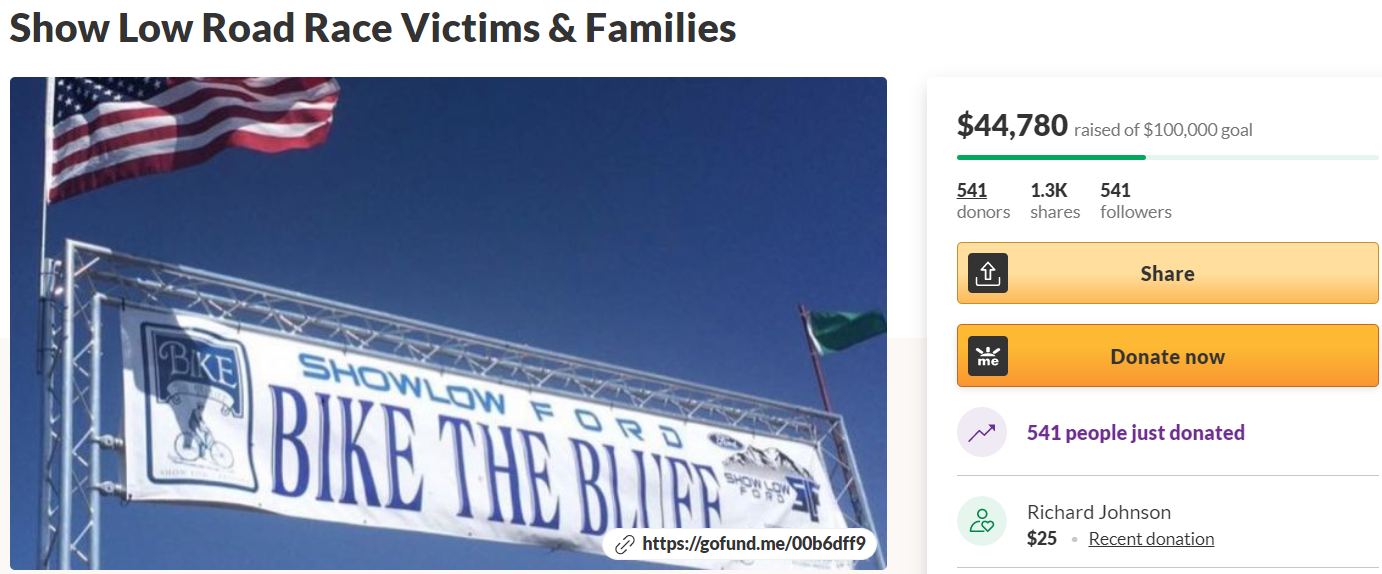By now you have probably seen reports of the heinous tragedy in Arizona where a homicidal driver plowed into a group of riders, sending 7 people to the hospital, some with life-threatening injuries, and giving rise to a police chase that ended with the malicious driver being shot and apprehended. Everything about this case is horrible, from the impacts on those riders and their families, to the collective hit of anxiety lobbed at every rider across the country, to the divisive conversations rippling through the internet from the keyboard-wielding, dehumanizing motoring public.
Please consider supporting the riders and their families at this Go Fund Me.
https://www.gofundme.com/f/show-low-road-race-victims-families
Anti-cyclist sentiment is a subject seldom entertained at policy-making tables. But for just about any policy that would seek to improve safety for humans using our transportation network by regulating how cars are piloted, discussions about road rage develop. And the very threat of increased road rage often has the counter-productive result of limiting that policy’s chance of success.
The House patron of our 2021 Bicyclist Safety Act, Delegate Chris Hurst, said while supporting this bill on the floor that all of us, including himself, should give people more space to make our roadways safer and more inviting. He admitted to not being a bicyclist and that this bill made sense to him as a driver who shares the road with bicyclists in his area and across the Commonwealth.
The bill’s requirement for drivers to change lanes to pass and the right for bicyclists to ride side-by-side will take effect July 1, 2021. This is a new opportunity for us to educate drivers, riders, and anyone who uses our roads and streets on the new rules and the values within. Our roads are for everyone. They should be safe. And everyone should feel invited to use them, for we all pay for them.
Like any policy, the tenants of the Bicyclist Safety Act were not uniformly supported by all riders. It is not that any bicyclist would prefer to have close passes by drivers, because every rider, experienced or brand new, knows that cars are what make bicycling feel or actually be dangerous. And it is certainly not that bike riders do not understand the benefit of riding next to each other for visibility, expeditious overtaking, or socializing.
What the minority of reluctant bike riders worry about is that drivers will overreact and literally take the new laws out on them. They are afraid of road rage, because we know that we will always lose a battle with a negligent, distracted, reckless, or homicidal driver. And truth be told, the longer you ride, the more of these drivers you encounter. It’s something you never forget, and fear is a powerful motivator.
Something that drivers never, ever have to consider is that fear. As a dominant aggressor, they tend to get what they want, and they know it. That road rage becomes self-enforcing, the way a physically abusive relationship prevents a victim from defending oneself for fear of increased violence. The answer for some is to give up biking, or to never start. And that is a tragedy in itself.
When we talk about the policies Virginians want, or could want, to have a safer riding experience, let us not be intimidated by this aggression. We need to go bold: to go after aggressive driving, to go after repeated offenders, and to continually build places for riders to exist beyond car access.
I am asking you to slow down. Take a breath before passing a bicyclist. You will feel better if you give them a friendly wave, and so will they. And you will still arrive alive. As Sgt. Ike, a colleague at Richmond Police Department once told me, the cure for road rage is leaving on time.
Until then, spread the word about Virginia’s new bike laws, and send some love to our friends in Arizona.
Brantley Tyndall
VBF

Comments on this entry are closed.
What I want to know as a transit bus driver is: may I go over a double yellow line to completely change lanes to avoid passing too closely to a bicyclist, or do I have to break my schedule in order to follow and follow and follow as a bicyclist weaves his/her way up a hill? We have lots of hills here. It was reasonable to put my left wheels temporarily over the line in order to give an appropriate distance. But actually driving wholeheartedly into the path of oncoming traffic, in something as ponderous as a bus, is too much for me. I cycle too and appreciate things that make it safer, but my job is being hampered if I cannot pass over the double yellow line. The law seems to not have taken this into account ad I cannot find a ruling on this anywhere, even at my company.